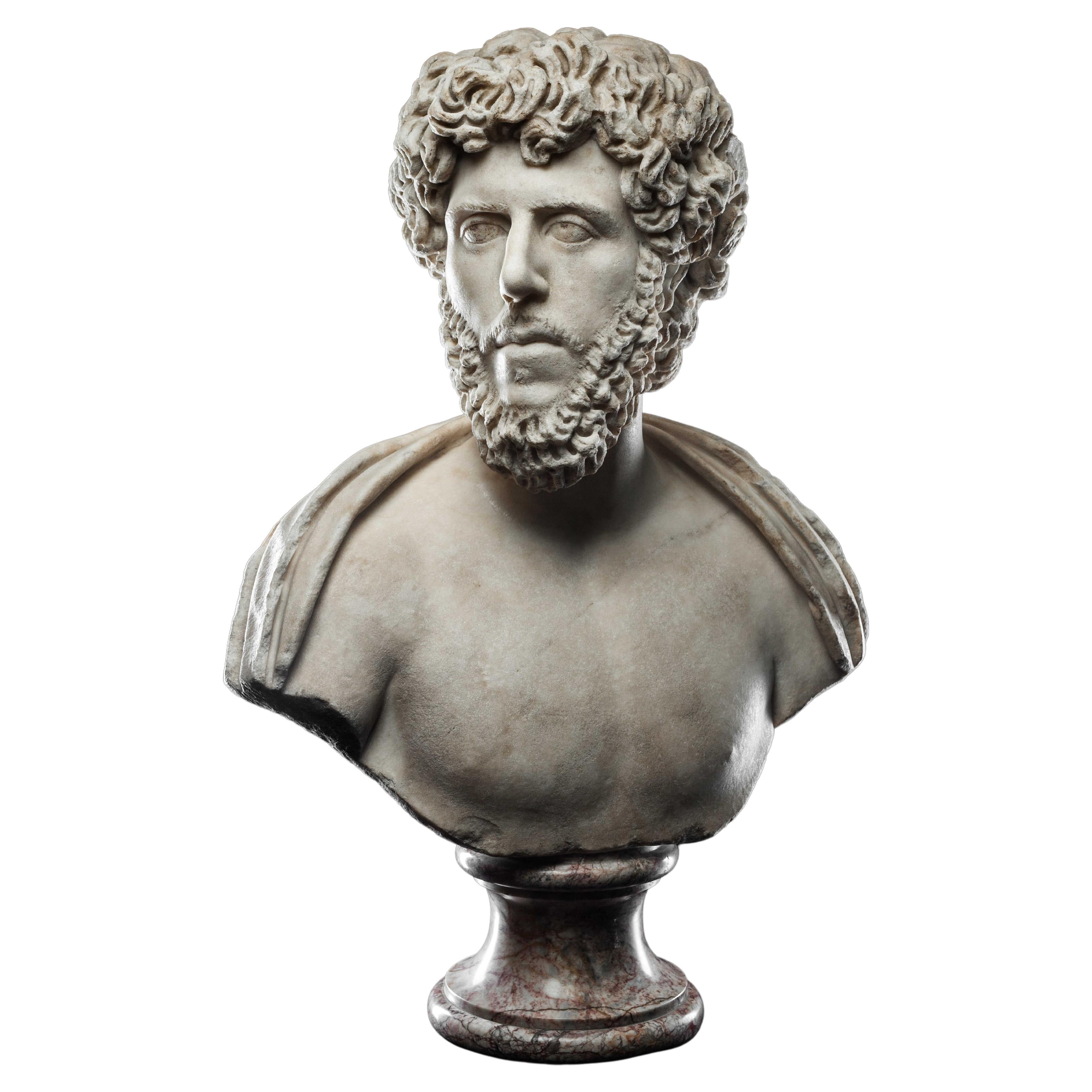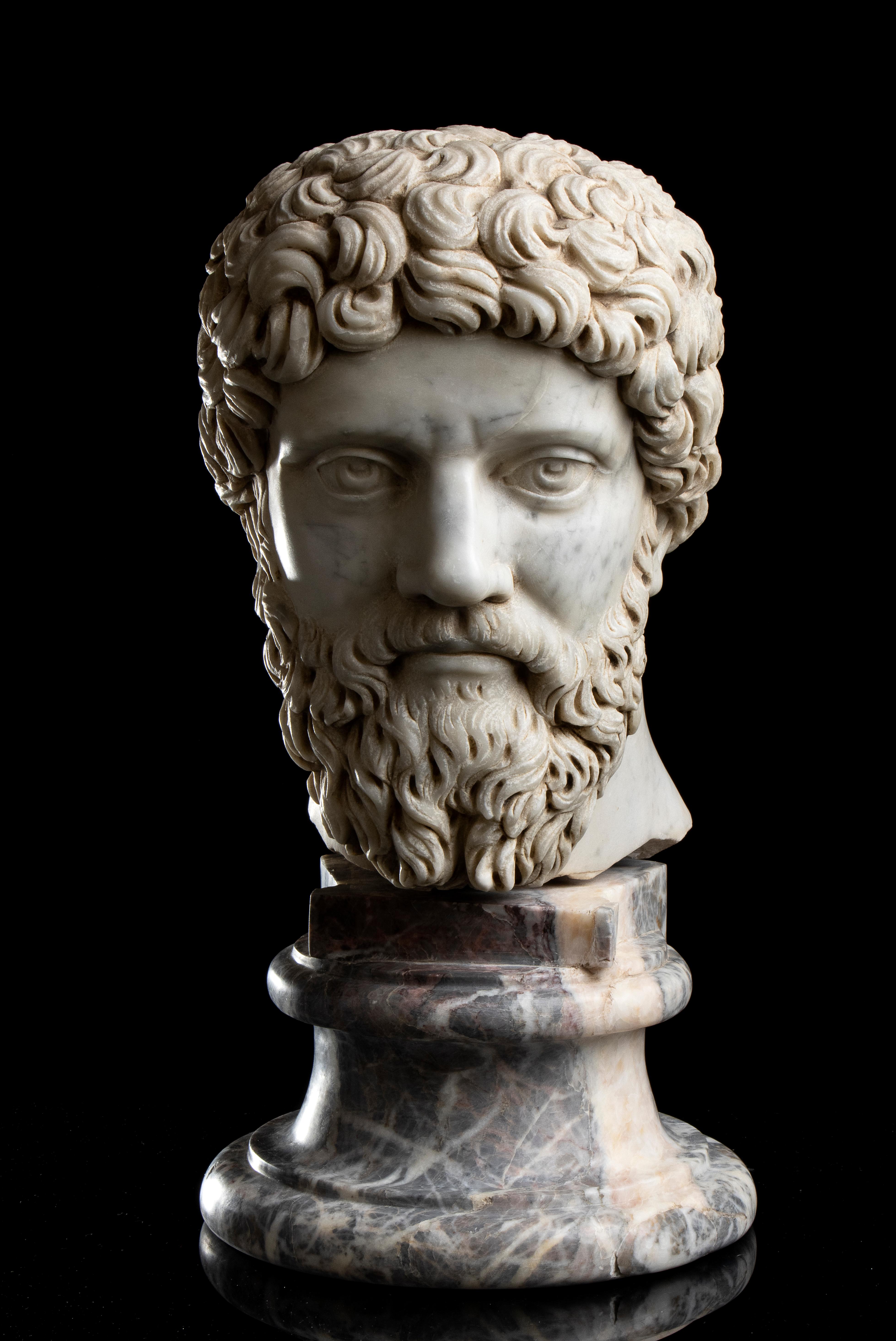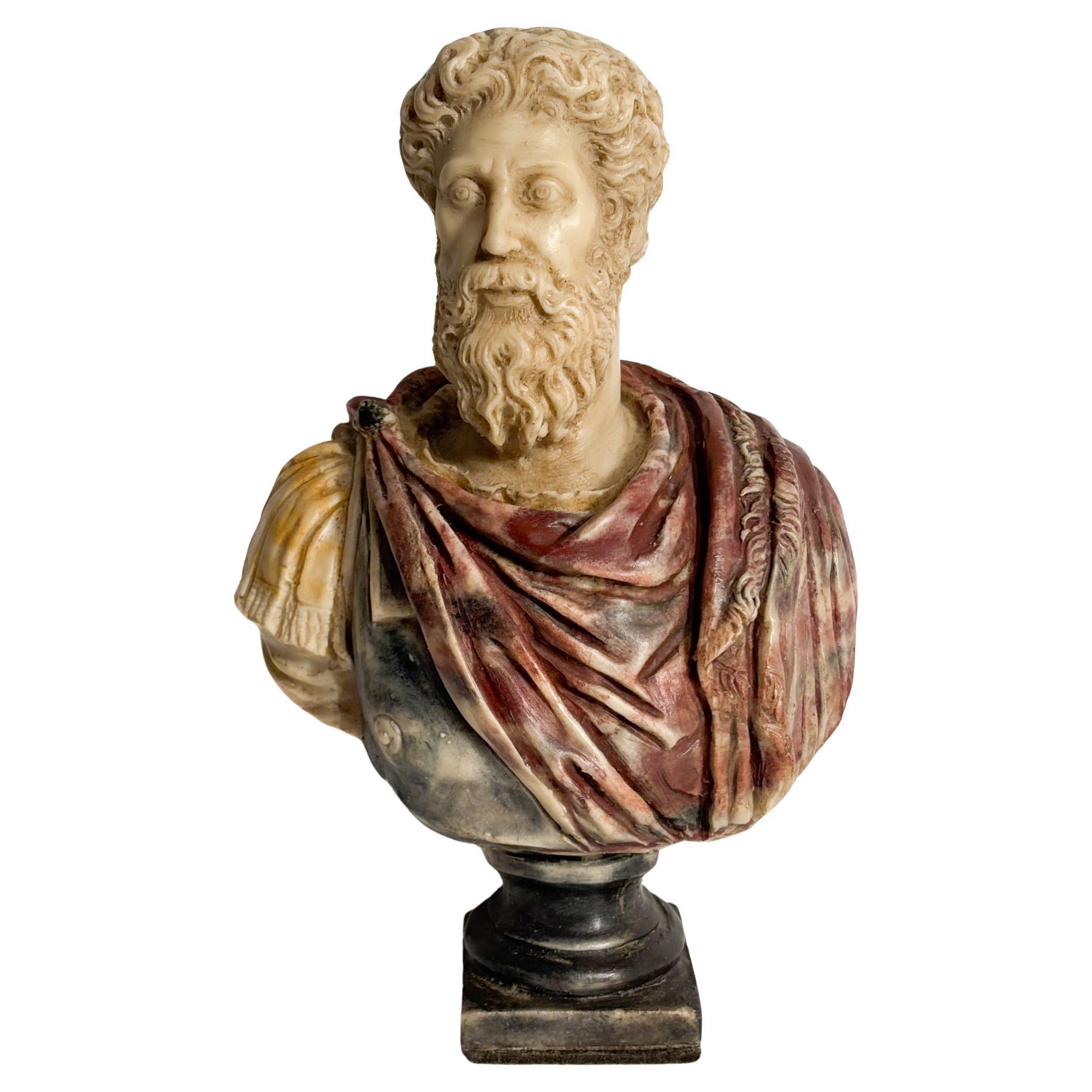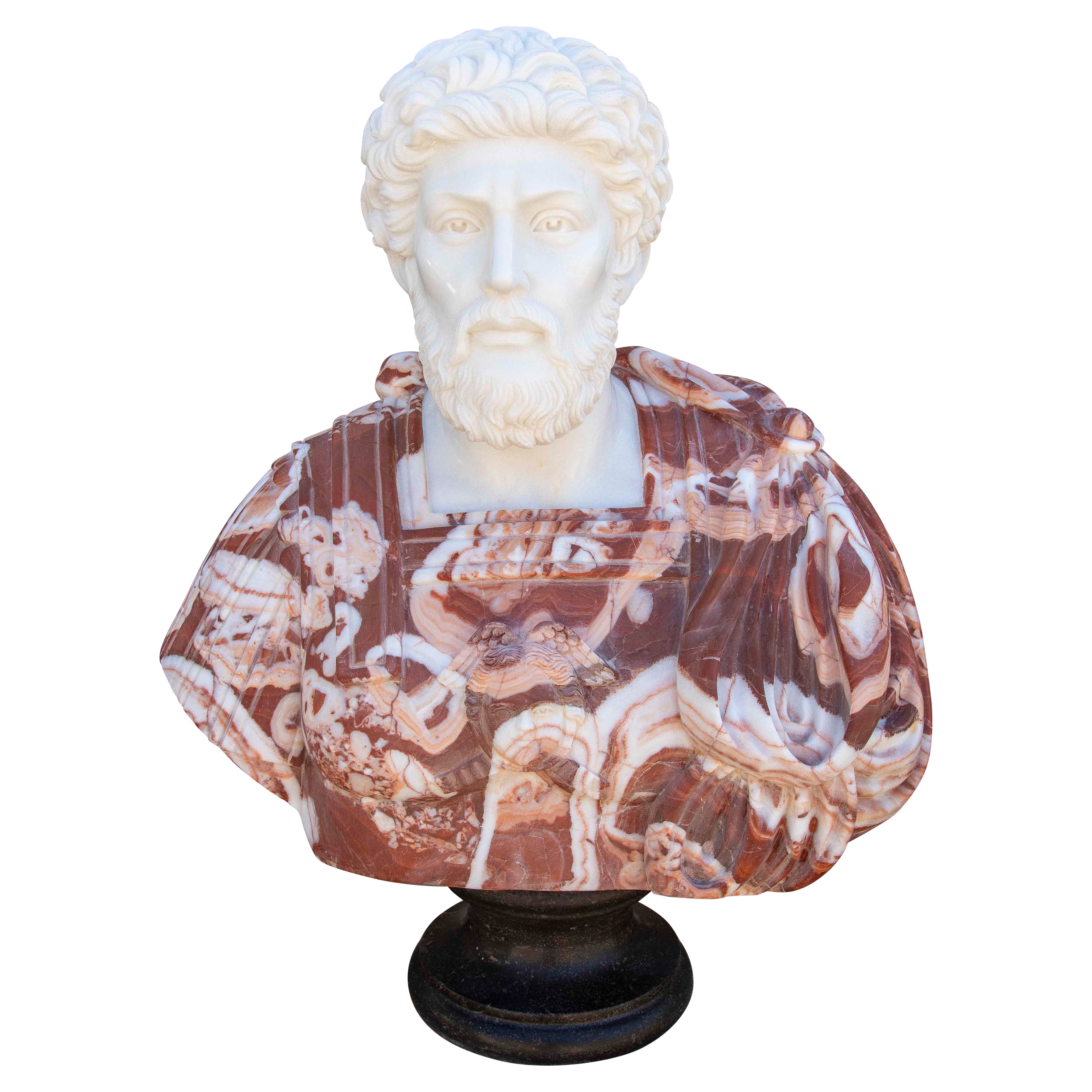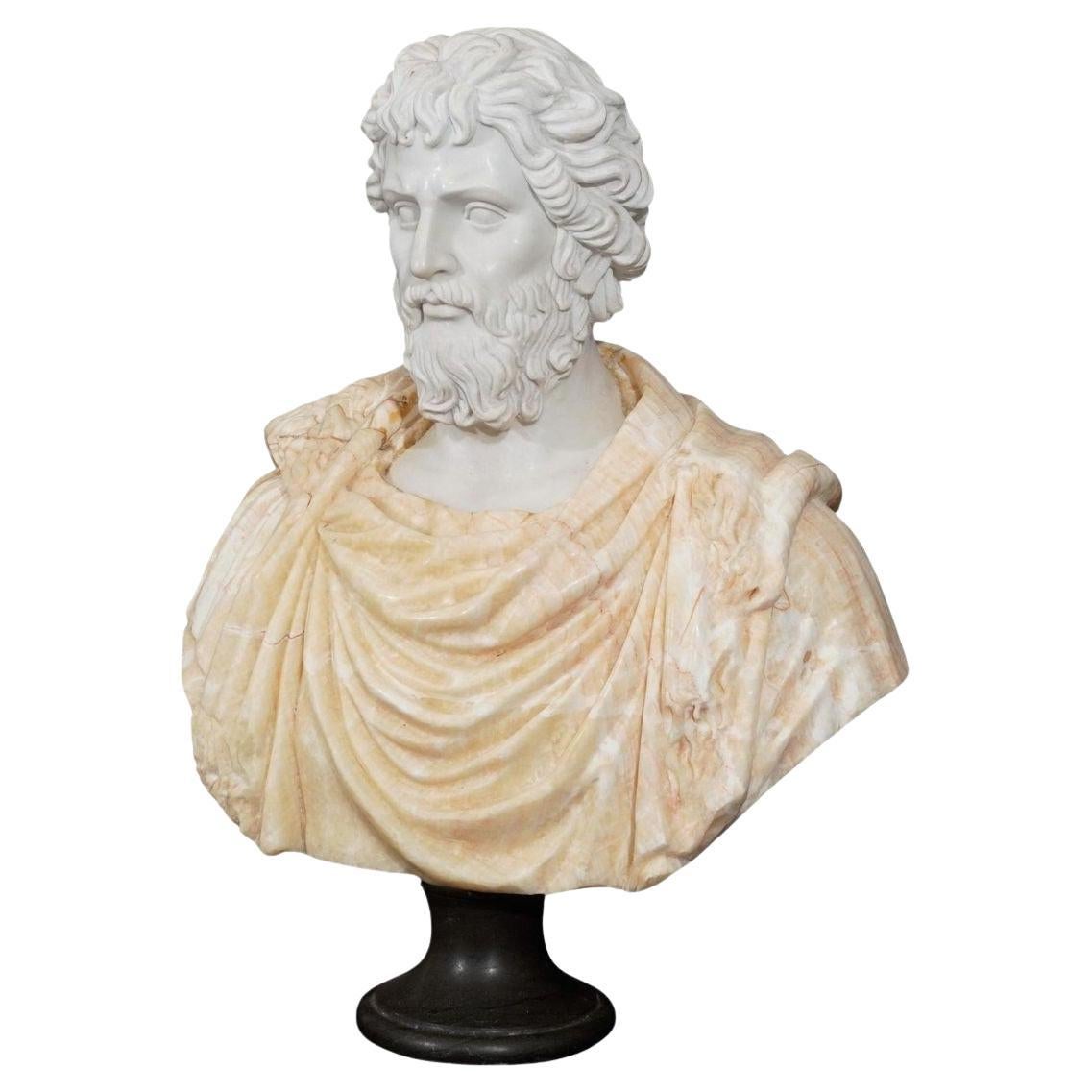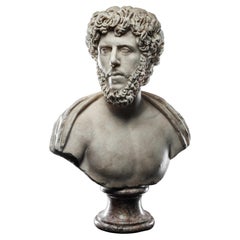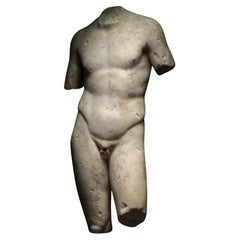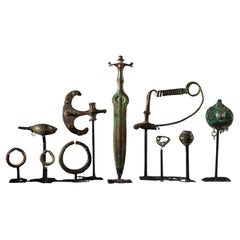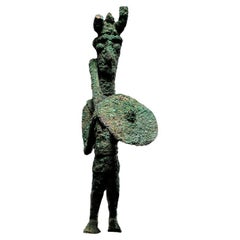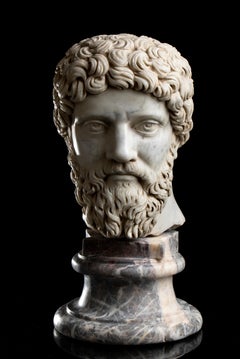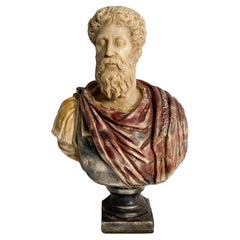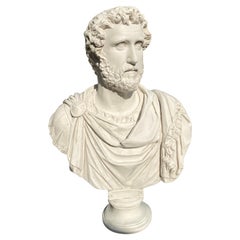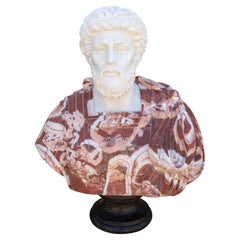Items Similar to Portrait Head of Emperor Marcus Aurelius
Want more images or videos?
Request additional images or videos from the seller
1 of 21
Portrait Head of Emperor Marcus Aurelius
$358,787.81
£260,500
€307,085.05
CA$494,307.35
A$549,583.99
CHF 289,389.28
MX$6,668,107.33
NOK 3,663,810.16
SEK 3,424,769.57
DKK 2,291,646.63
About the Item
A marble portrait head of the Roman emperor Marcus Aurelius (r. 161-180 A.D.), in his fourth and final portrait type. Known as the Capitoline Imperatori 38 type, after the most famous example, these portraits were created towards the end of his reign, between 170 and 180 A.D.. The emperor is depicted with a long beard, falling in waves and coils around his chin. His hair is full and curled high over the face, and falls in orderly rows on the reverse. His facial features are stern, without appearing harsh, with firmly set eyebrows slightly drawn together above sharp almond-shaped eyes. Strong cheekbones and a pensively downturned mouth complete the image of the emperor as ruler and philosopher.
The later portraits of Marcus Aurelius embody his status as emperor and one of the great Stoic philosophers. He was trained in philosophy and governance from a young age. Despite the economic and military pressures affecting his reign, he endeavoured to write a philosophical treatise in Greek. His Meditations are a series of metaphysical reflections on duty, virtue, justice, and the subordination of the individual to the tasks facing the wider community, which still hold value today: ‘People exist for the sake of one another; teach them, then, or bear with them’. Historians Cassius Dio (c. 155-235 A.D.) and the author of the fourth century Historia Augusta, refer to Marcus Aurelius as ‘the philosopher’. He was introduced to philosophy in his early teens, around 132 A.D., by a teacher named Diognetus. He was probably introduced to the Cynic Philosophers, who sought to live a simple life and disregard all social conventions as artifice, which Aurelius followed – opting to dress in a rough woollen cloak, and sleeping on the ground rather than a bed. He was also tutored in oratory and rhetoric by the highly respected Herodes Atticus and Marcus Cornelius Fronto, who advised him throughout his life. The fuller beard of his later portraits symbolises wisdom and philosophical depth, and his features hold an introspective seriousness. As with Hadrian and Antoninus Pius before him, Marcus Aurelius’s portraits recall those of Greek philosophers from five hundred years previous, with broad faces, thick beards and curled hair.
Marcus Aurelius was betrothed to Ceionia Fabia, daughter of respected politician Lucius Ceionius Commodus, and sister of his future co-emperor, Lucius Verus (r. 161-169 A.D.). In 136 A.D., Hadrian selected Lucius Ceionius Commodus as his successor, possibly in order to secure the succession of the then teenage Aurelius. After Commodus died in 138 A.D., Hadrian then selected Aurelius Antoninius as his successor, on the stipulation that he adopted Aurelius and Lucius Verus as his sons and successors. Aurelius’s earlier betrothal was annulled and he was married to Antoninus’ daughter Anna Galeria Faustina (known as Faustina the Younger) in 145 A.D.. Antoninus coached Aurelius on how to become an efficient ruler, and brought Apollonius of Chalcedon and the Stoic Quintus Junius Rusticus to court to tutor him in philosophy.
When Antoninus Pius died in 161 A.D., Aurelius refused to accept the role of emperor unless Lucius Verus was elevated alongside him. The pair began their reign by instituting programs to help the poor and reward the military with greater pay and honour. They encouraged free speech, the arts, education, and boosted the economy by debasing the currency; making the two emperors highly popular with the people. While Verus was fighting the Parthian Wars (161-166 A.D.), Aurelius remained and Rome and managed internal affairs, until 167, when he joined the campaign against the Marcomanni tribe of Germania and the Persia Sarmatians. Verus died in 169 A.D., and Aurelius continued to rule alone, and spent much of the remainder of his reign in the field against the Germanic tribes. Aurelius led Rome to victory in 178 A.D., and retired to winter quarters at Vindobona, where he died in 180 A.D.. His Meditations were copied and preserved, with the first printed edition published in 1559.
- Dimensions:Height: 17.72 in (45 cm)Width: 11.03 in (28 cm)Depth: 15.75 in (40 cm)
- Style:Classical Roman (Of the Period)
- Materials and Techniques:
- Place of Origin:
- Period:
- Date of Manufacture:Circa 170-180 A.D.
- Condition:Repaired: Both eyes and brows partially restored and over-painted. Minor infill on some chips over the hair at the front and proper right side. Wear consistent with age and use. Main area of damage over the nose and lips. Large chips over the hair above the forehead. Some losses to the edge of.
- Seller Location:London, GB
- Reference Number:Seller: D44991stDibs: LU5517246237182
About the Seller
5.0
Vetted Professional Seller
Every seller passes strict standards for authenticity and reliability
Established in 1910
1stDibs seller since 2020
- ShippingRetrieving quote...Shipping from: London, United Kingdom
- Return Policy
Authenticity Guarantee
In the unlikely event there’s an issue with an item’s authenticity, contact us within 1 year for a full refund. DetailsMoney-Back Guarantee
If your item is not as described, is damaged in transit, or does not arrive, contact us within 7 days for a full refund. Details24-Hour Cancellation
You have a 24-hour grace period in which to reconsider your purchase, with no questions asked.Vetted Professional Sellers
Our world-class sellers must adhere to strict standards for service and quality, maintaining the integrity of our listings.Price-Match Guarantee
If you find that a seller listed the same item for a lower price elsewhere, we’ll match it.Trusted Global Delivery
Our best-in-class carrier network provides specialized shipping options worldwide, including custom delivery.More From This Seller
View AllAncient Marble Portrait Bust of a Bearded Man possibly Lucius Verus
Located in London, GB
This impressive bust is depicted with head turned slightly to the right and gaze lifted. His eyes are articulated, with the pupils indicated with a drill, giving the face a striking realism. The shoulders are draped with a cloak. Straight brows sit beneath a mass of thickly curling hair, which continues to a full beard. It is worked with great skill, evident in the heavy drill work articulating and highlighting the voluminous curls, and the highly polished surfaces, giving the appearance of soft skin. The contrast between these textures gives a chiaroscuro affect which is one of the main traits of the best Antonine busts.
Roman marble portraits reached their apotheosis of craftmanship and technique under the Antonine emperors, as is evidenced in this masterful bust. The evolution of the style may be traced back to the emperor Hadrian, who was the first emperor to wear a full beard. The articulation of pupils and iris appears on busts of his lover Antinous, a novelty which continued in later Antonine portraits, such as this one. The features of this bust point to a possible identification of Emperor Lucius Verus...
Category
Antique 15th Century and Earlier Busts
Materials
Marble
Torso of a Youth
Located in London, GB
A marble statue of a youth in contrapposto position. The torso is idealised but has only softly suggested muscles, giving the impression of youth. The beginnings of the slender arms ...
Category
Antique 15th Century and Earlier European Antiquities
Materials
Marble
$419,117
Corsican Bronze Hoard
Located in London, GB
Dagger L: 27.8 cm,
Luniform bronze, possibly a belt buckle L: 10.8 cm,
Shield-shaped bronze with a point Diam: 6.5 cm,
Pommel Diam: 3.7 cm,
Violin-bow brooch L: 17.5 cm,
P-Shape...
Category
Antique 15th Century and Earlier European Classical Roman Antiquities
Materials
Bronze
$89,249 / set
A Sardinian Figure of a Warrior
Located in London, GB
An exceptionally rare and important Sardinian bronze figure of a warrior. The highly stylized figure is depicted standing, holding a club resting on his shoulder in the right hand an...
Category
Antique 15th Century and Earlier Italian Antiquities
Materials
Bronze
$188,690
‘Maple’ Sub-Adult Triceratops Skull
Located in London, GB
A skull of a sub-adult Triceratops prorsus from the Maastrichtian, late Cretaceous period (68-65 million years ago).
The triceratops roamed the plains of what is now North America ...
Category
Antique 15th Century and Earlier North American Natural Specimens
Materials
Bone
Bowl with Kufic Inscription
Located in London, GB
Glazed ceramic bowl with a convex wall and everted rim. With a cobalt blue inscription in the centre which reads, “baraka li-sahibihi” (blessing to its owner).
Ceramics such as t...
Category
Antique 15th Century and Earlier Iraqi Antiquities
Materials
Ceramic
$30,300
You May Also Like
Polychrome Marble Sculpture Portrait Emperor Marcus Aurelius Italian 19th
Located in Roma, IT
A portrait head of the Roman Emperor Marcus Aurelius, carved in Carrara marble, with deeply cut curls and detailed classical roman accents in the hair and in the shave; the carefull...
Category
19th Century Other Art Style Figurative Sculptures
Materials
Marble
Polychrome Resin Bust of Roman Emperor Marcus Aurelius 1950s
Located in Milano, MI
Polychrome resin bust depicting the Roman emperor Marcus Aurelius, made in the 1950s
Ø cm 17 Ø cm 9 h cm 26
Category
Vintage 1950s Italian Classical Roman Busts
Materials
Resin
Bust of Hadrian - 20th Century Roman Emperor Sculpture
Located in Southall, GB
This 20th-century bust of Hadrian captures the distinguished presence of the Roman Emperor known for his intellect, military leadership, and architectu...
Category
20th Century European Busts
Materials
Marble
Hand-Carved Marble Bust of Roman Emperor with Base
Located in Marbella, ES
Hand-Carved Marble Bust of Roman Emperor with Base
Category
Late 20th Century European Busts
Materials
Marble
Early 20th Century Roman Emperor Septimius Severus Multicolor Marble Bust
Located in Los Angeles, CA
A finely crafted multicolor marble bust of Roman Emperor Septimius Severus, representing the refined artistry of classical Roman portraiture. The emp...
Category
Early 20th Century Italian Busts
Materials
Marble
Sculpture, Bust of Hadrian
Located in Rome, IT
Sculpture of Hadrian in dark patina bronze, 20th century, produced by Antiche fonderie Napoletane. ADDITIONAL PHOTOS, INFORMATION OF THE LOT AND SHIPPING INFORMATION CAN BE REQUEST B...
Category
20th Century Figurative Sculptures
Materials
Bronze
